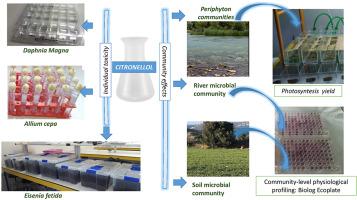Journal of Environmental Management ( IF 8.0 ) Pub Date : 2021-03-11 , DOI: 10.1016/j.jenvman.2021.112303 María Rosa Pino-Otín , Elisa Langa , Jonatan Val , Ana M. Mainar , Diego Ballestero

|
Citronellol is an acyclic monoterpenoid with a wide range of pharmacological activities (antibacterial, antifungal, anti-lice, repellent, lipolytic, anti-allergic, anti-inflammatory, antispasmodic, antidiabetic, anti-cholesterol, among other) and potential to replace synthetic products. However, the impact of citronellol on the environment remains unknown.
We analysed, for the first time, the environmental impact of citronellol on river and soil environments using non-target model organisms and natural populations. The acute toxicity of citronellol on the aquatic invertebrate Daphnia magna, the plant Allium cepa L and the earthworm Eisenia fetida was quantified. The effect of citronellol in a river ecosystem was analysed using river periphyton communities taxonomically characterised and a river microbial community characterised through 16 S rRNA gene sequencing. Finally, a microbial community from natural soil was used to monitor the effect of citronellol on the soil ecosystem.
The results showed that E. fetida was most sensitive to citronellol (LC50 = 12.34 mg/L), followed by D. magna (LC50 = 14.11 mg/L). Citronellol affected the photosynthesis of the fluvial periphyton (LC50 = 94.10 mg/L) and was phytotoxic for A. cepa. Furthermore, citronellol modified the growth and metabolism of both fluvial (LC50 = 0.19% v/v) and edaphic (LC50 = 5.07% v/v) bacterial populations. The metabolism of the microorganisms in the soil and water exposed to citronellol decreased with respect to the control, especially their ability to metabolise carbohydrates.
Our results show that citronellol has a negative impact on the environment. Although acute effects cannot be expected, it is necessary to quantify the environmental levels as well as the long-term and persistent effects of this monoterpene.
中文翻译:

香茅醇对非目标模式生物和自然种群对河流和土壤环境的影响
香茅醇是一种无环的单萜类化合物,具有广泛的药理活性(抗菌,抗真菌,抗虱子,驱蚊,脂解,抗过敏,抗炎,抗痉挛,抗糖尿病,抗胆固醇等),并且有可能替代合成产品。但是,香茅酚对环境的影响仍然未知。
我们首次使用非目标模型生物和自然种群分析了香茅酚对河流和土壤环境的环境影响。对水生无脊椎动物香茅醇的急性毒性水蚤,植物洋葱大号和蚯蚓蚯蚓进行定量。香茅醇在河流生态系统中的作用通过使用分类学表征的河生藻生物群落和通过16 S rRNA基因测序表征的河流微生物群落进行了分析。最后,使用天然土壤中的微生物群落来监测香茅酚对土壤生态系统的影响。
结果表明,f。fetida对香茅醇最敏感(LC 50 = 12.34 mg / L),其次是D. magna(LC 50 = 14.11 mg / L)。香茅醇影响了河流附生(LC的光合作用50 = 94.10毫克/升),并用于植物毒性A.洋葱。此外,香茅醇修饰了河流 细菌(LC 50 = 0.19%v / v)和水生细菌(LC 50 = 5.07%v / v)的生长和代谢。暴露于香茅醇的土壤和水中的微生物的代谢相对于对照而言,尤其是其代谢碳水化合物的能力下降。
我们的结果表明,香茅酚对环境有负面影响。尽管无法预期会产生急性影响,但必须对环境水平以及这种单萜的长期和持久影响进行量化。






























 京公网安备 11010802027423号
京公网安备 11010802027423号